Organic Evolution Exam 3 Study Guide
1/75
Earn XP
Description and Tags
Lectures 13 - 23
Name | Mastery | Learn | Test | Matching | Spaced |
|---|
No study sessions yet.
76 Terms
How do organisms reproduce: asexual reproduction
mode of reproduction that doesn’t require union of gametes
asexual lineages are overwhelmingly of recent origin
how do organisms reproduce: sexual reproduction
fusion of male and female gametes
cyclical parthenogenesis
some organisms do both asexual and sexual reproduction
a form of asexual reproduction in which the embryo develops directly from an egg without the need for fertilization
some organisms alter between asexual and sexual reproduction using this method
found in gall wasps and aphids
parthonogenesis has evolved independently hundreds of times, yet it’s still very rare among haplodiploid arthropods
what is the two-fold disadvantage of sex?
while sexual reproduction is generally favored, there is a cost associated with it
asexual females always give rise to females
sexual females give rise to both males and females
sex reproduces the net reproductive rate because males cannot reproduce and producing them instead of females impedes further reproduction
this is known as the demographic cost of males
generally, selection should favor evolution of asexual reproduction
why is there still sexual reproduction despite the fitness costs?
chromosome reshuffling and recombination allows:
faster reassembly of beneficial mutations
reducing load of harmful alleles (see mueller’s rachet)
adaptation to varying environments
faster tracking of phenotypic optimum (red queen hypothesis)
mueller’s rachet
related to evolution of sex as opposed to asexual reproduction
associated with load reduction of harmful allelesf
asexual lineages accumulate multiple mutations across tens of thousands of loci
genetic load of deleterious mutations keeps ratcheting up
this is the cost of asexuality
recombination unlinks harmful mutations from beneficial alleles exposing them to purifying selection
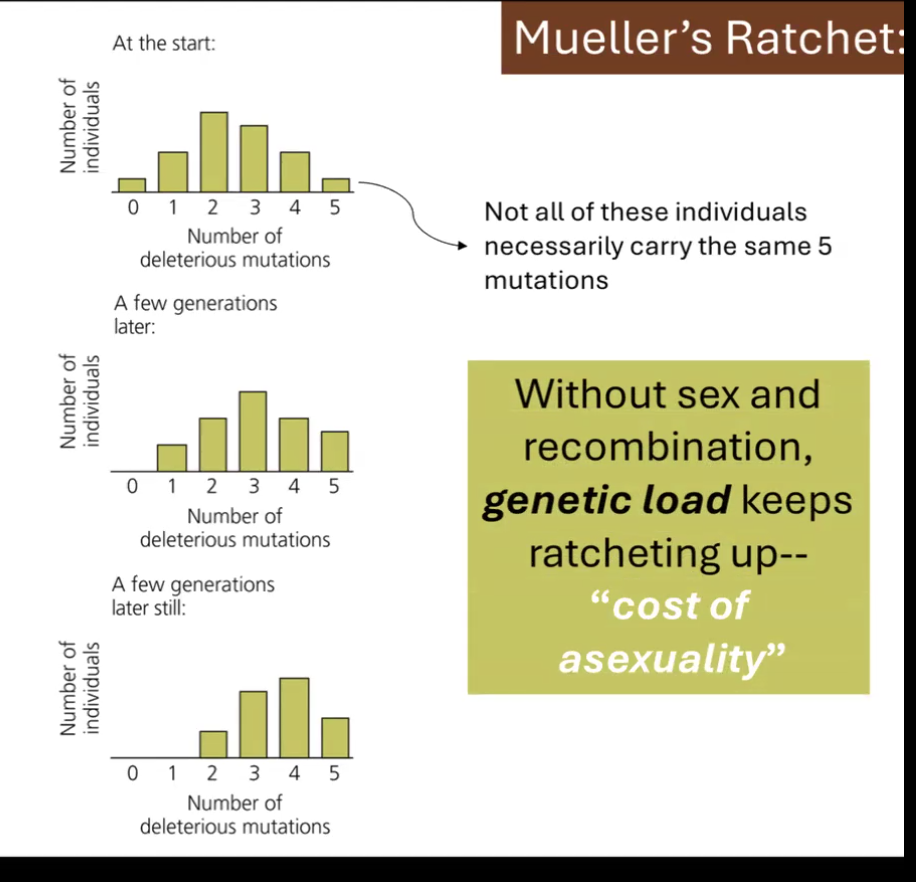
red queen hypothesis
sex is maintained because it allows host species to counter evolve to parasites and pathogens
you must run as fast as you can just to stay in place
co-evolutionary arms race
recombination allows for novel allele combinations that may provide an advantage against parasites and/or hosts

sexual selection
refers to differential reproduction success resulting from competition for fertilization
can occur through competing individuals of the same sex
OR it can occur through attraction to the opposite sex
sexual selection acts differently on each sex
Why is sexual selection asymmetric
parental investment differs between the sexes (eggs are more expensive than sperm)
this is Bateman’s principle

reproductive success in the heavily investing sex is limited by time and energy
low variation in fitness, weak sexual selection
reproductive selection in the lightly investing sex is limited by the number of mates
high variation in fitness, strong sexual selection
intrasexual consequences of sexual selection
relates to overt combat over access to females
larger body size
weaponry
armor
tactical cleverness
intersexual consequences of sexual selection
attraction to the opposite sex
colorful phenotype
courtship song
courtship dance
why don’t we see infinite optimization of these traits that are sexually selected?
there are tradeoffs between survival and reproduction
reduced fitness in male phenotypes that stand out
higher predation rates among males due to bright coloration
increased mortality with intense fighting
why do females prefer certain traits that are under sexual selection? In other words, why be choosy?
direct fitness benefits
enhance females’s survivability or fecundity
protection
territories/nests
food
help with parental care
reduce risk from contagious diseases
indirect fitness benefits
enhance survivability or attractiveness of a female’s offspring
male traits as indicators of “good genes”
females may also have pre-existing biases which evolved in response to other selective pressures (foraging, predator avoidance, etc)
pre-existing biases may select male displays even if they originally have no relation to mating or fitness
male coloration is a byproduct of natural selection
example in fishes: females feed on orange food and can see this color really well, and males that happen to have this color have better fitness outcomes
sexual conflict
evolution of phenotypic characteristics that confer a fitness benefit to one sex but a fitness cost to another
male adaptations to intrasexual selection can be costly to females
extraneous copulations can lead to a potential loss of foraging opportunities, physical harm, and sexually transmitted diseases
what is social behavior?
interactions with other members of the same species
can be competition/aggression or cooperation/altruism
why does altruism exist?
natural selection favors the survival of the fittest, so why would individuals sacrifice their precious energy and time to help others?
to answer this, we must look at kin selection (Hamilton’s rule)
Hamilton’s rule
inclusive fitness = direct fitness (personal reproduction) + indirect fitness (reproduction by relatives)
fitness benefit to actor must outweigh the fitness cost
prediction: individuals should behave altruistically towards kin more than towards unrelated individuals
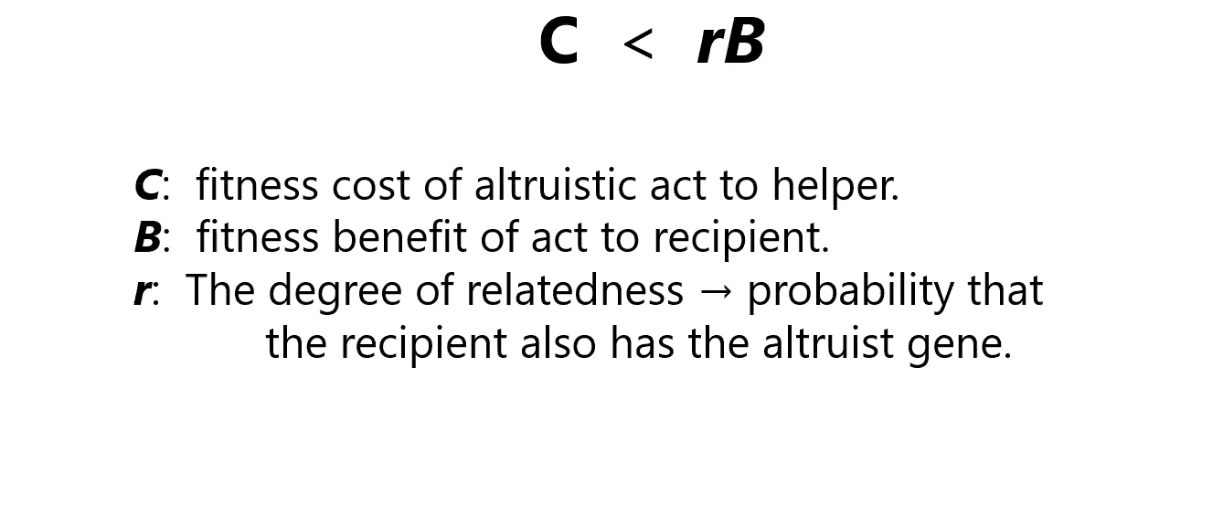
eusociality
extreme cooperative breeding
relies on reproductive division of labor: reproductive and sterile (worker) castes
cooperative brood care: workers care for queen’s offspring
overlapping generations: queens and adult offspring exist in same colony
in haplo-diploid societies, females share have their genes with daughters and sons
males share half with daughters
sisters share ¾ of their DNA
workers are more genetically releated to their sisters than to their own offspring, and so by foregoing their own reproduction to hel sisters that will be queens, the helper genes get spread
game theory
deals with interactive decision making, where the outcome for each participant or player depends on the actions of all
say you have two prisoners:
if both prisoners remain silent, they each get two years
if either one confesses, their sentence is reduced to one year while the other’s is increased to 8 years
however, if they both confess, they both get 5 years in prison
it’s best strategy to confess
evolutionary game theory is a way of thinking about evolution at the phenotypic level when the fitness of particular phenotypes depend on their frequencies in the population
relates to hawks and doves game (See card)
Hawk and Dove game
hawk = aggressive strategy
dove = cooperative strategy
V = benefit of cooperation
C = cost of escalation, the more intense the aggresion, the higher the cost
relies on a payoff matrix
this payoff matrix allows us to calculate the absolute fitness, W, of each strategy
When C>V, the hawk genotype cannot go to fixation
as the more competitive gentoype increases in frequency, its fitness gain through inflicting aggression on others is countered by the damage it receives from an increasing number of aggressors
genes for aggression can create social nevironment that decreases its expected fitness
in other words, fitness is frequency-dependent
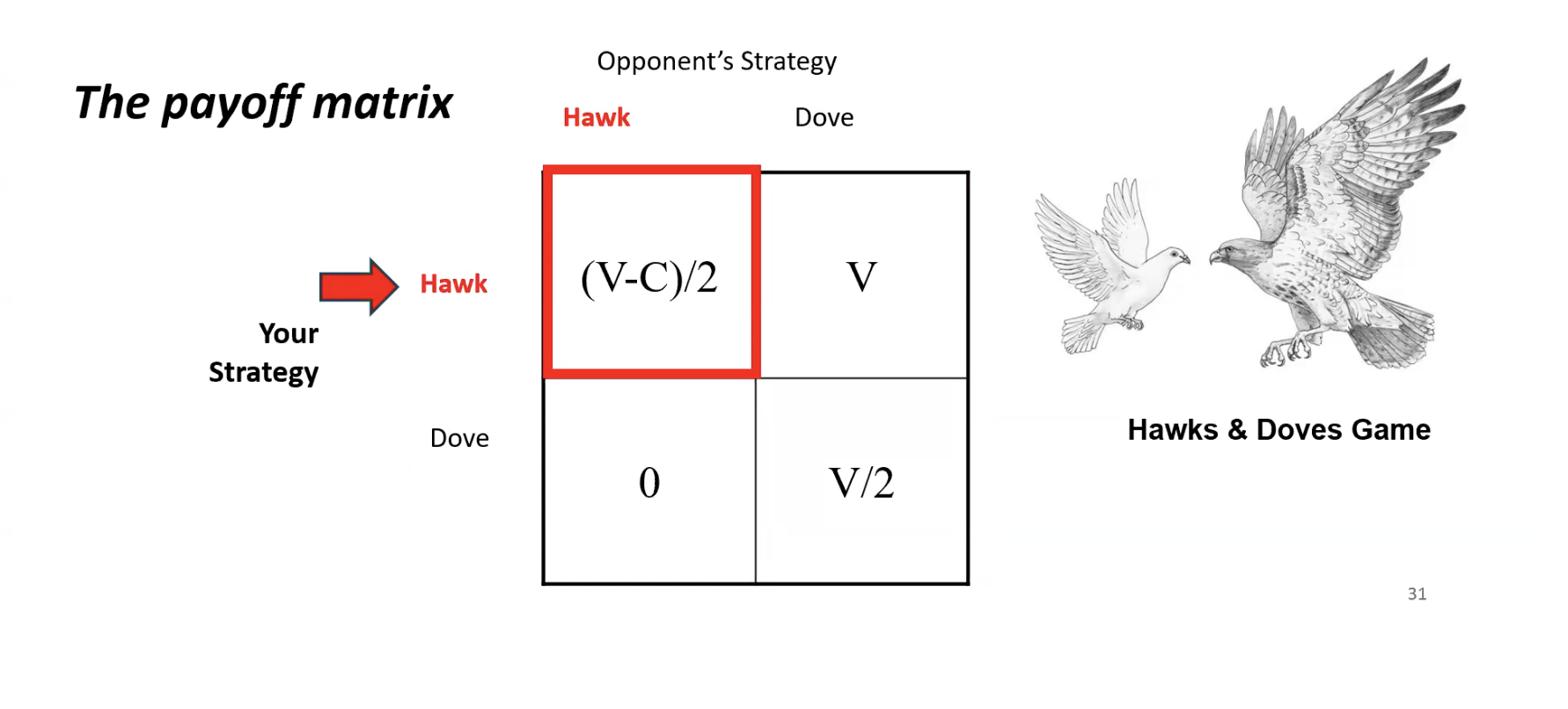
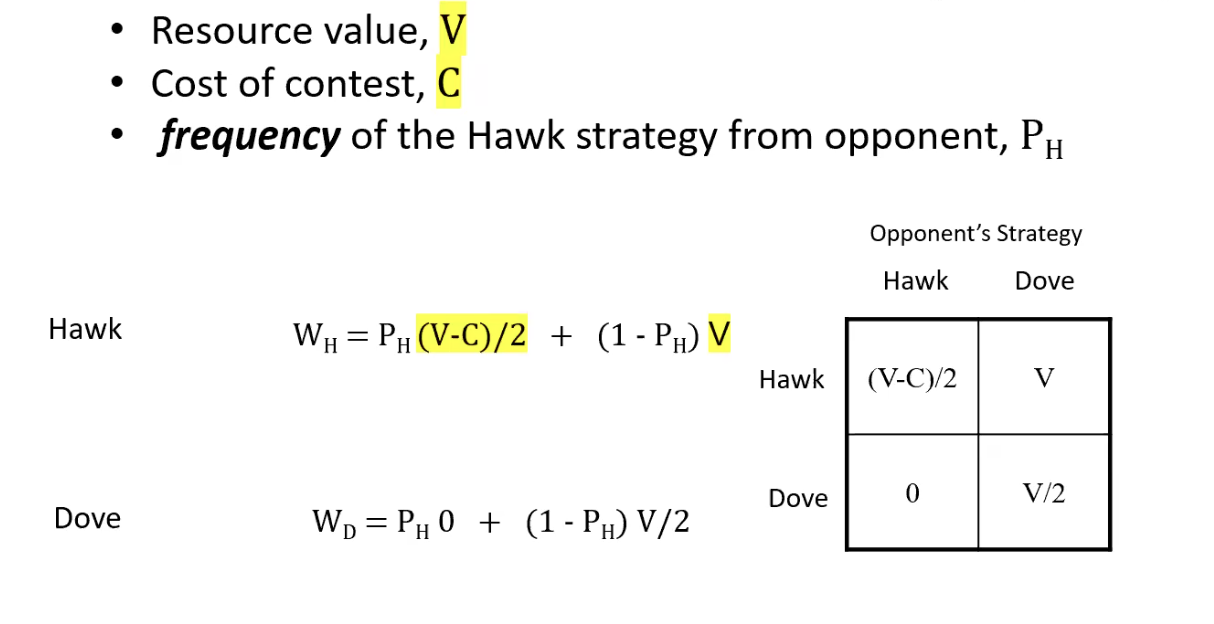
types of species interactions:
interactions between species:
competition
mutualism
predation
commensalism
coevolution
evolutionary change in one species may evoke a reciprical change in another species
relates to reciprical selection (See card)
reciprocal selection
selection that occurs in two species due to their interactions with one another
critical prerequisite of coevolution
coevolutionary arms race
reciprocal selection on predator and prey species
elude and evade traits are selected for in prey species
hunt and capture traits are selected for in predator species
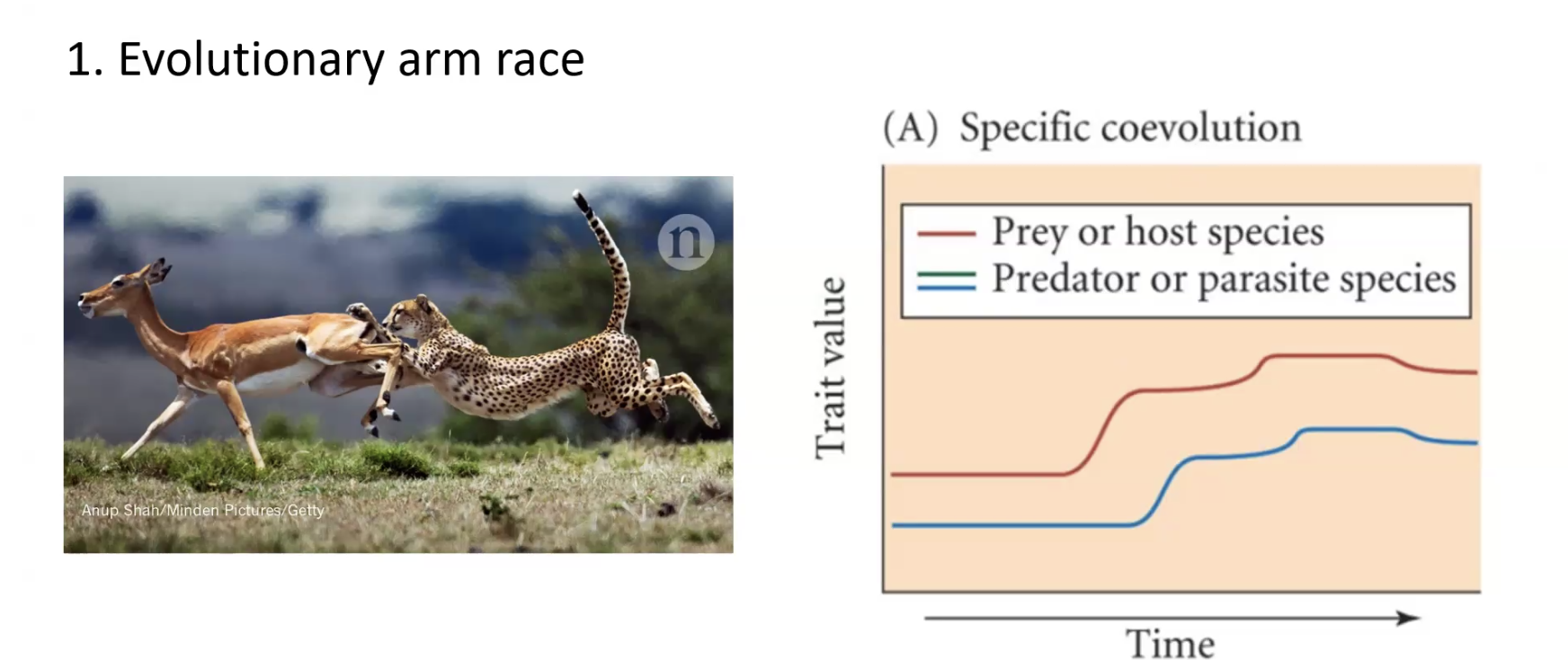
diffuse coevolution
unlike evolutionary arms race which is a 1:1 evolution, diffuse evolution is a multiple:multiple species interaction and pattern
describes the evolution of similar traits in several species in response to a set of selective pressures imposed by one or more interacting species
ex: shrubby plant species often evolve thorns and unpalatable leaves to protect them from grazing herbivores of various species

escape and radiate coevolution
mode of coevolution where one of several prey or host species evolves a major new defense
this new defense allows it to escape typical association with predator or parasite and allows it to diversify further
later, a different predator or parasite adapts to the host clade and diversifies

concordant phylogenies
between host and specialized parasite/pollinator
direct 1:1 linkage between two interacting species

discordant phylogenies
between host and specialized parasites/pollinators
much more common in nature
multiple:one relationships, often multiple parasites to one host
most common reason for discordant phylogenies is host shift: organisms shift to start feeding on different host
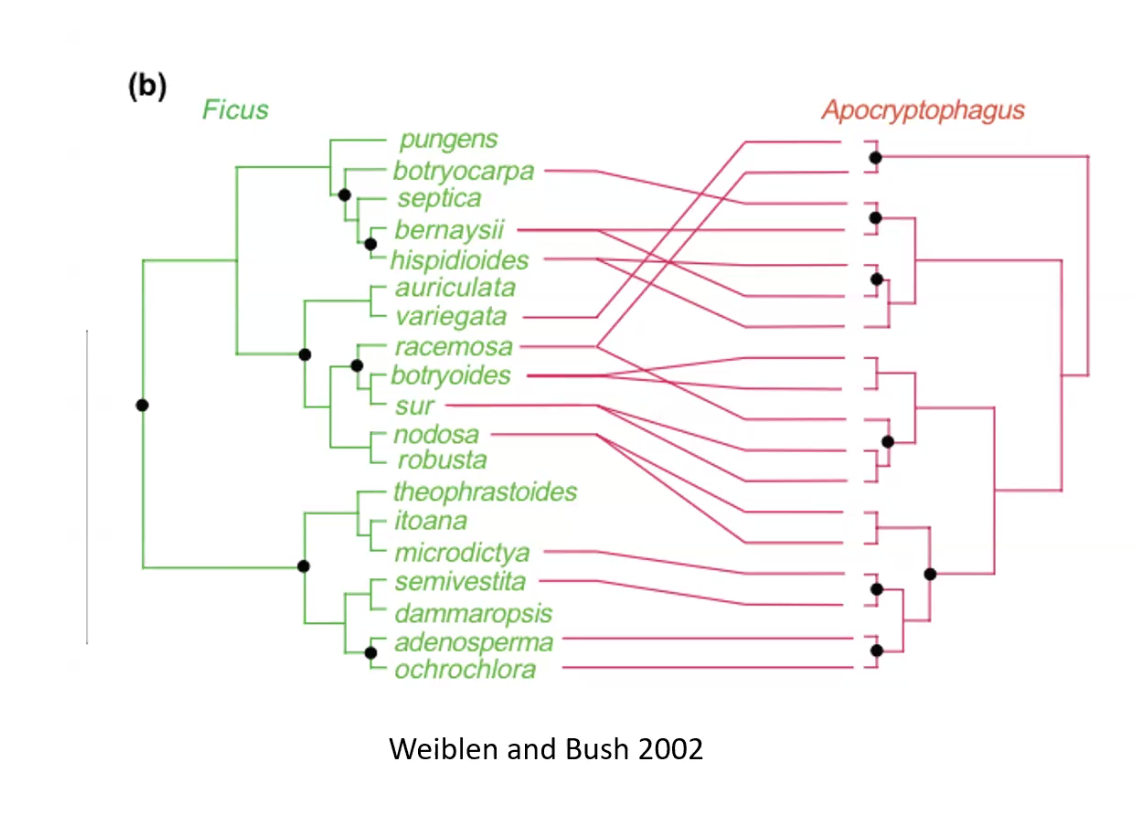
geographic mosaic theory
based on three observations:
species are often collections of genetically distinct populations
interacting species often differ in their geographic ranges
interactions among species differ between environments in their ecological outcomes
geographic and environmental variation can exert selection on pair-wise species interactions leading to reciprical local adaptation in traits of both species
three main predictions of geographic mosaic theory:
natural selection on species pairs varies across landscapes and environments
variation occurs because genes are expressed in different ways in different environments (GxE interactions)
how one species affects the evo fitness of another species depends on the environment where the interaction is occuring
coevolutionary hotspots
intensity of reciprocal selection differs among environments
trait remixing: mismatched coevolved traits will occur due to gene flow, extinction of local populations, genetic drift, or mutations
typological species concept
linnaeus
individuals conform to morphological type
limitation: cannot address convergent evolution
phylogenetic species concept
joel craft
a cluster of individuals recognizably different from other such clusters, descending from a common ancestor
populations within a species (e.g. B1-B3) are more closely related to each other than any other species
has monophyletic groups (see card)
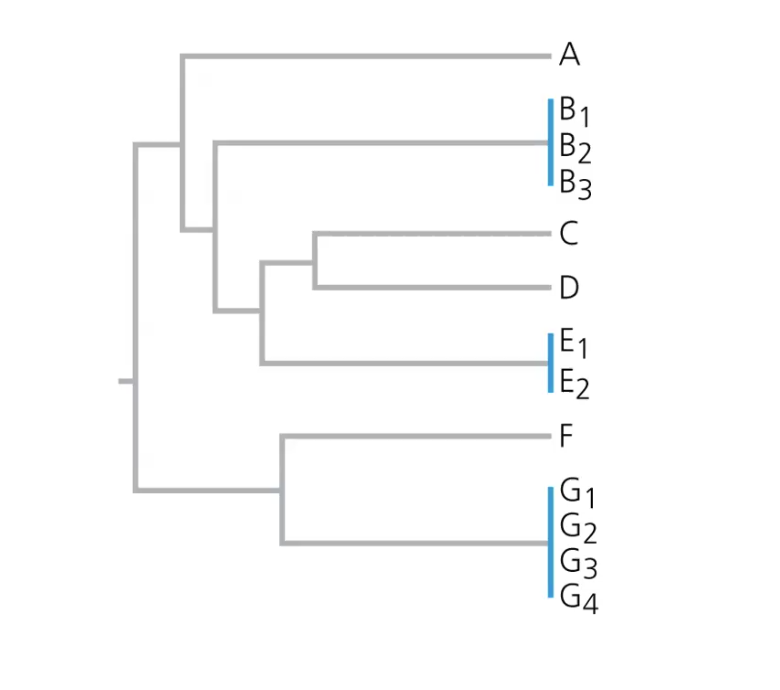
monophyletic group
relates to phylogenetic species concept
a species name is given to a collection of populations which operates under the assumption that they all descend from a common ancestor
includes ancestor and all of its descendants

what are the limitations of the phylogenetic species concept
requires well supported and thorough phylogenies
it’s difficult to decide how similar the populations within a clade must be to gain species designation
biological species concept
E. Mayr
species defined as group of actually or potentially interbreeding natural populations which are reproductively isolated from other such groups
this concept groups organisms based on reproductive isolation
this works because species rarely or do not hybridize in nature
it’s a biologically meaningful definition because it confirms lack of gene flow
defines a species as a discrete unit of evolution, which forms a boundary for the spread of alleles
difficult, however, to determine whether or not species are reproductively isolated
like in asexual species or in extinct species
also difficult to apply the concept to species that are geographically separated
What are the broad mechanisms of reproductive isoation?
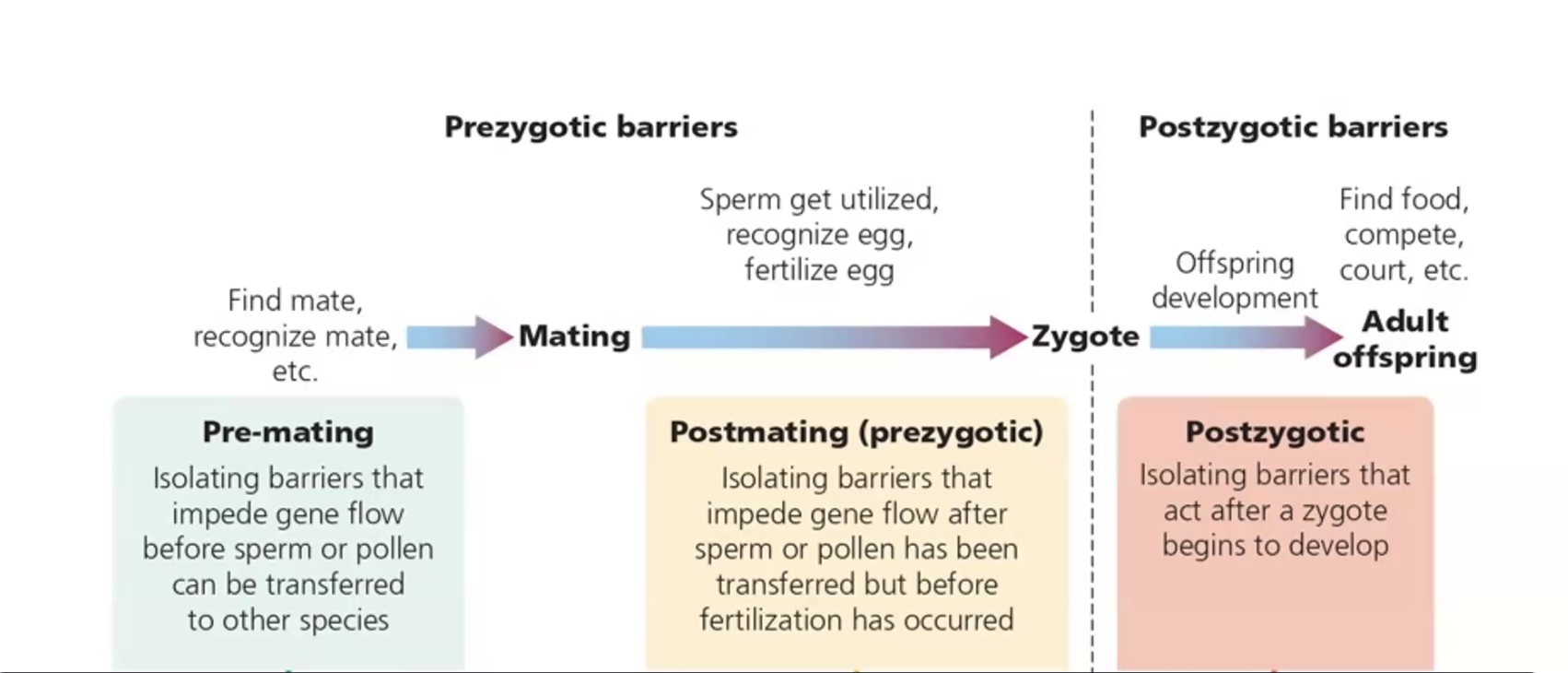
reproductive isolation: pre-mating barriers
prezygotic
isolating barriers that impede gene flow before sperm or pollen can be transferred to other species
ecological isolation
habitat
temporal
pollinator
behavioral isolation
mechanical isolation
genital incompatibilities that arise through genital coevolution
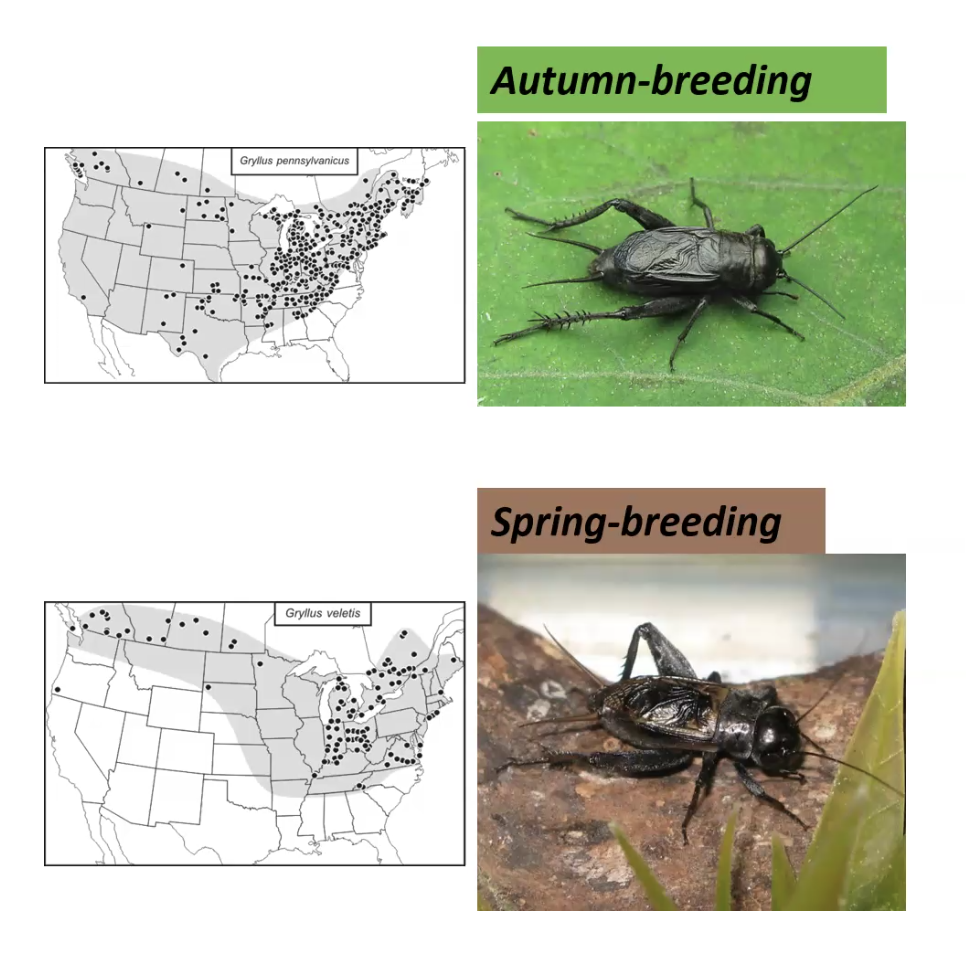
reproductive isolation: post-mating, pre-zygotic isolation
isolating barriers that impede gene flow after sperm or pollen transfer, but before fertilization
copulatory behavioral isolation
gametic isolation
sperm and egg are able to meet, but they’re incompatible and cannot form a zygote
example in sea urchins which which all release sperm and egg into sea water
reproductive isolation: post-zygotic isolation
isolating barriers that act after a zygote begins to develop
isolation can either be intrinsic (independent of the environment) or extrinsic (fitness of hybrid depends on the environment)
post-zygotic intrinsic isolation
intrinsic isolation
hybrid inviability—> hybrids can form, but embryos often have lethal morphology
hybrid sterility—> mule (sterile hybrid of horse and donkey)

post-zygotic extrinsic isolation
ecological inviability
hybrids have half of the genes of each parent, producing intermediate phenotype that's maladapted to either parental environment
behavioral sterility
same concept as ecological inviability, but with mating instead
hybrids have difficult time attracting mates because of their intermediate phenotype that is unattractive to both parental species

how do reproductive barriers evolve?
necessary to understand evolutionary forces causing reproductive isolation
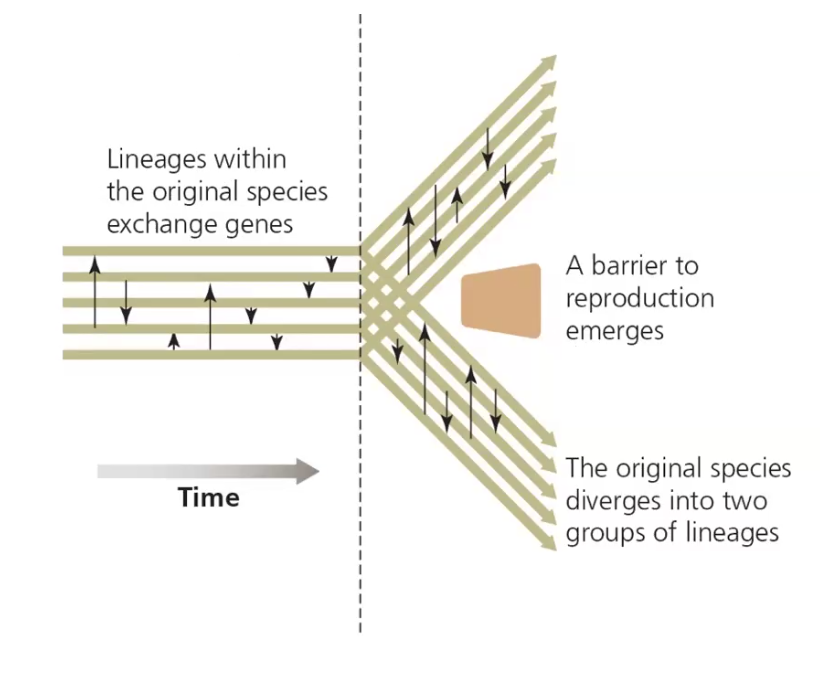
allopatric speciation
isolation of populations, typically via geographic barrier
gene flow eliminated
divergence through selection and drift
reproductive isolation arises as a correlated trait or by chance
if the barrier is removed and they make contact again:
positive selection for mating behaviors that reinforce reproductive isolation
for this to occur, there must be a cost of interspecific mating, like sexual isolation of hybrids
can also result in fusion (incipient speciation reversal) or hybrid speciation

what is the mechanism for reproductive isolation in allopatric species once the geographic barrier is removed?
in absence of selection
dobzhansky-muller incompatibilities
epistatic interactions between mutated genes creates less-fit hybrids
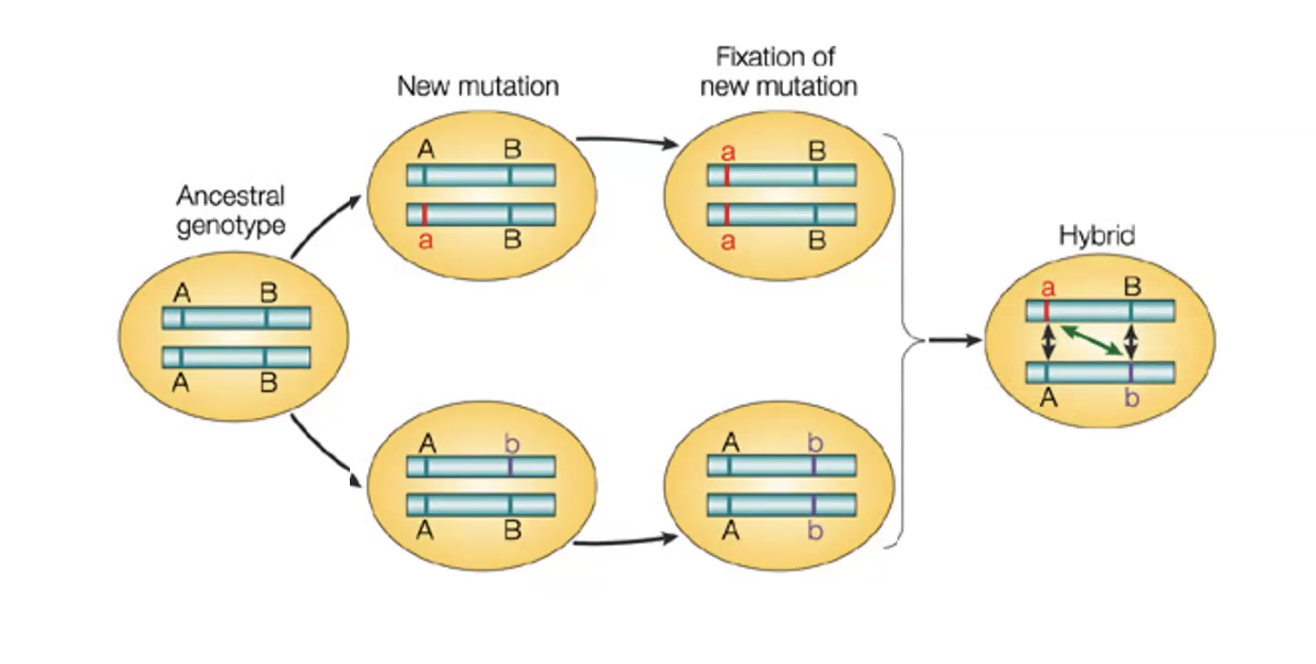
non-allopatric speciation
new species appear to arise without physical separation
can happen when a new host is introduced, new feeding niche promotes speciation
example in the hawthorne flies, which started feeding on apples that have different phenologies causing temporal isolation between the populations’
relates to ecological speciation (see card)
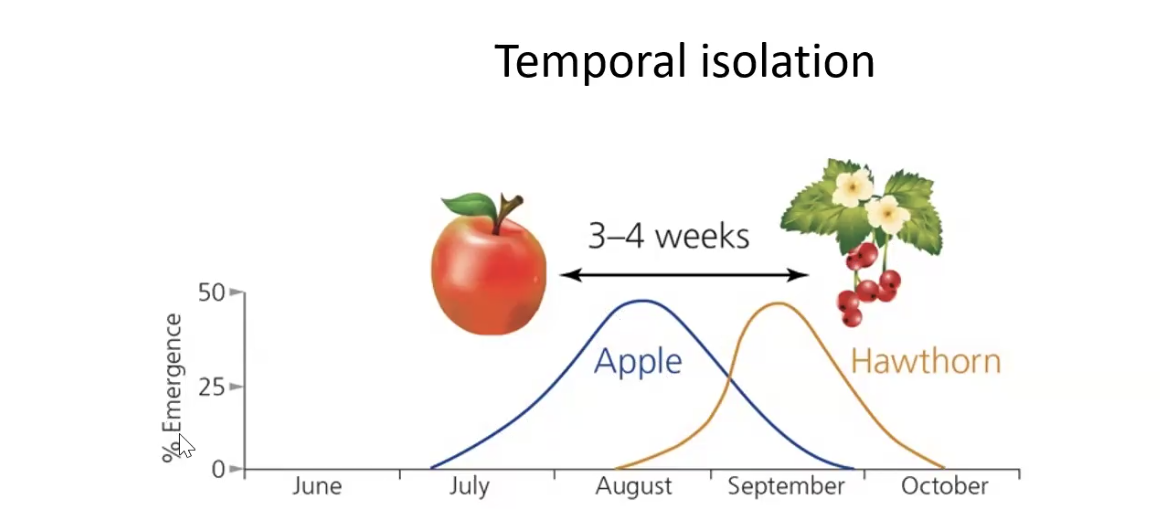
ecological speciation
reproductive isolation as a byproduct of adaptation
evolving between populations as a result of ecologically-based divergent selection
selection is strong enough to promote trait divergence even in face of gene flow
adaptive changes may inadvertently impact reproductive isolation as a byproduct
potential partners:
don’t meet
don't recognize each other
aren’t compatible during mating
produce unfit offspring
micro vs macroevolution
microevolution: populations and population changes
macroevolution: evolutionary patterns in different speices and how species are related to each other through evolutionary processes
the boundary between the two fields is the species:
if you talk about sub-species differences, this is microevolution
differences between species is macroevolution
what are the three main patterns in macroevolution
origin of major new forms of life
gradualism and saltation
evolution of novelty
patterns in macroevolution: origins of new forms of life
example: how did mammals evolve from other forms of life?
patterns in macroevolution: gradualism and saltation
evolution can occur either in incremental steps (gradualism) or large leaps (saltation)
this debate is shown in the evolution of cetatians (marine mammals)
the closest extant relative to a whale is a hippo, and there’s obviously a big morphological gap between those two species, suggesting saltation
however, macroevolutionary studies looking at extinct ancestors shows that there was a gradual change between land mammals and marine mammals
this concept can also be applied within one group of organisms, like turtles with the evolution of the carapice
turtles are an example of gradual evolution again, with a gradual movement of the shoulder blade within the ribcage
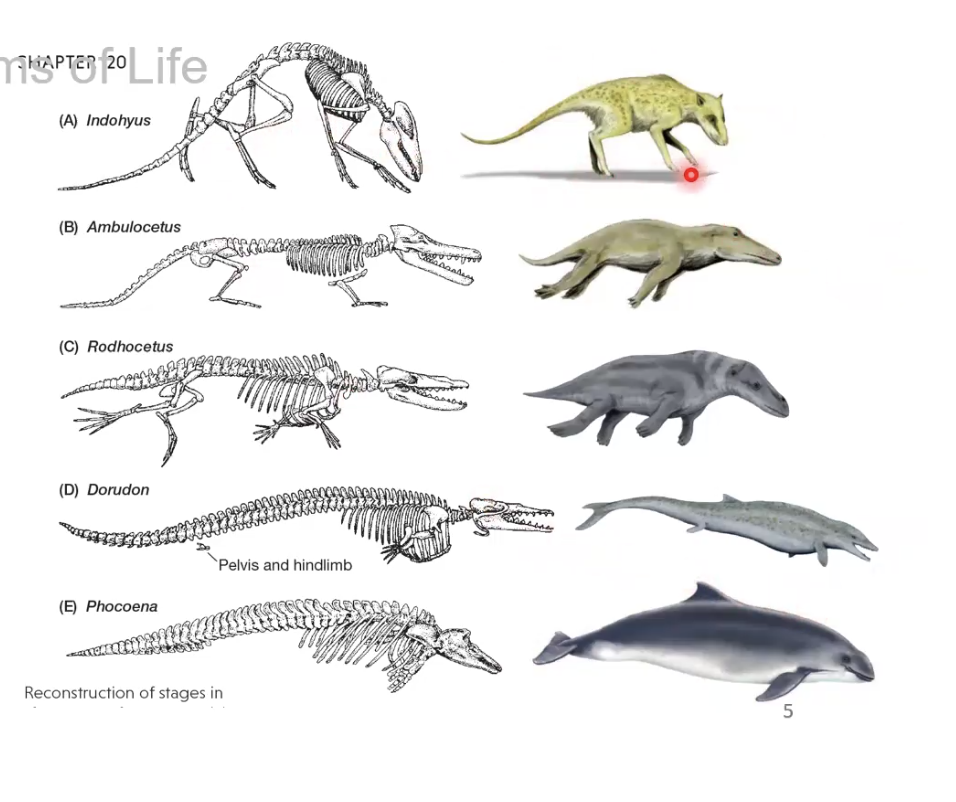
patterns of macroevolution: evolution of novelties
novelty: trait or character that is completely new to a group of organisms, oftentimes with a new function
example: evolution of eyes giving rise to vision
conflicts between micro and macroevolution: evolutionary rates
microevolution rates are muchhhh higher than macroevolutionary rates which creates a conflict
one potential explanation is due to the fact that macroevolutionary studies are limited by data
concepts that can connect the two fields:
paradox of stasis: living fossils
phylogenetic niche conservatism (habitat tracking)
stabilizing selection
genetic constraints like gene pleiotropy and genetic lines of least resistance
phylogenetic niche conservatism (habitat tracking)
some organisms can move to track their optimal niche instead of adapting to a changing environment
gives rise to low rates of change
genetic constraints with micro and macroevolution
gene pleiotropy—> one gene is responsible for multiple traits (one gene controlling hair and eye color)
evolutionary force working on one trait will inadvertently work on the other connected traits vis pleiotropy
genetic lines of least resistance
constrain evolutionary pathway of a species
punctuated equilibrium
long periods of no change interrupted by periods of sharp change creating a more diagonal, sharp line
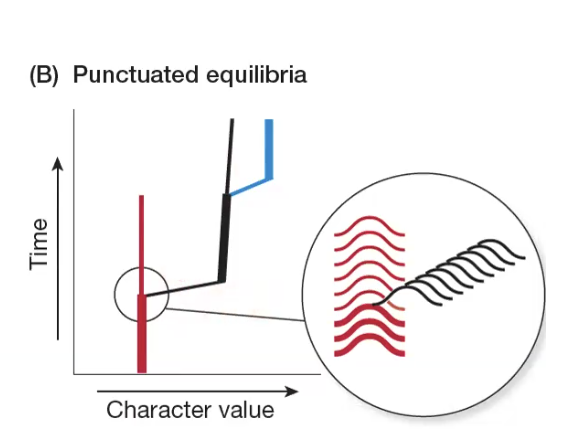
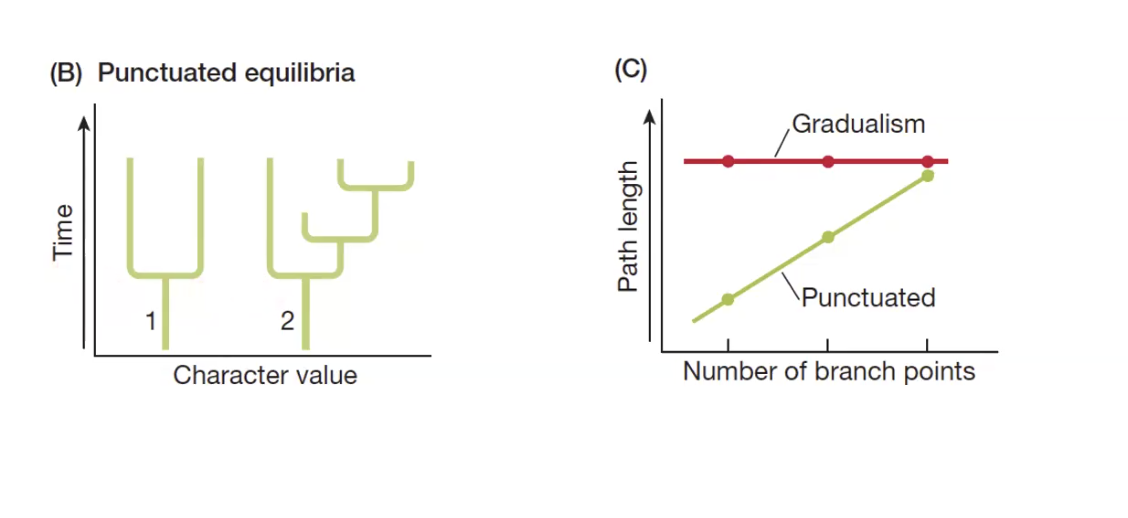
phyletic gradualism
organisms undergo very gradual change creating a smooth trait curve over time


macroevolution: passive trends
trend: describes persistent directional change of a trait over time
passive trends have larger variance
changes in character value are random but there is a lower or upper limit on the trait value
the average trait value might not change much, but the variance changes a lot, increasing as traits deviate from the mean
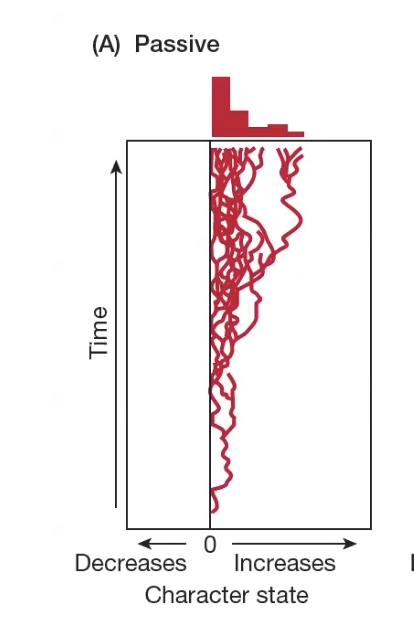
macroevolution: active trends
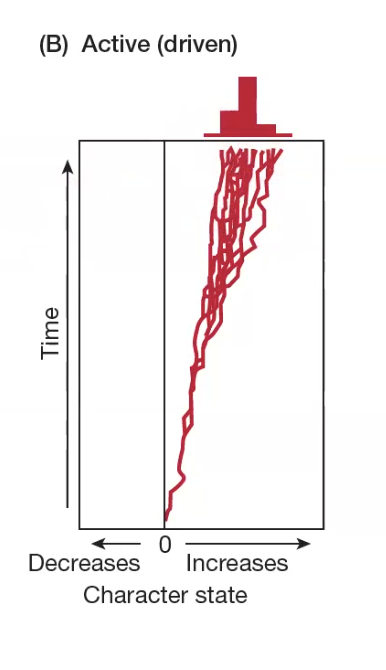
character state is persistently changing on one direction, changing the mean value of the trait, and not necessarily the variance
Cope’s rule
the tendency for organisms in evolving lineages to increase in size over time
not much empirical support for this rule
often thought to be an active trend because:
Larger size can confer advantages: predation resistance, greater reproductive success, thermoregulation, competitive ability.
In some groups (e.g., mammals, dinosaurs), many lineages do independently show size increases over time
What is a human
homo sapiens
obligate bipedalism
large brains
complex, symbolic behavioral capabilities
key trends in hominin evolution
bipedalism
dentition
diet
tools
brian
genetics
bipedalism
three main types:
habitual bipedalism—> regularly bipedal but uses other locomotion categories too
obligate bipedalism—> only bipedal; doesn’t use other locomotor capabilities
occasional bipedalism—> generally uses other locomotor categories but may occasionally use bipedalism
how can you tell if something is bipedal?
foramen magnum position (big hole)
where the spine enters the skull
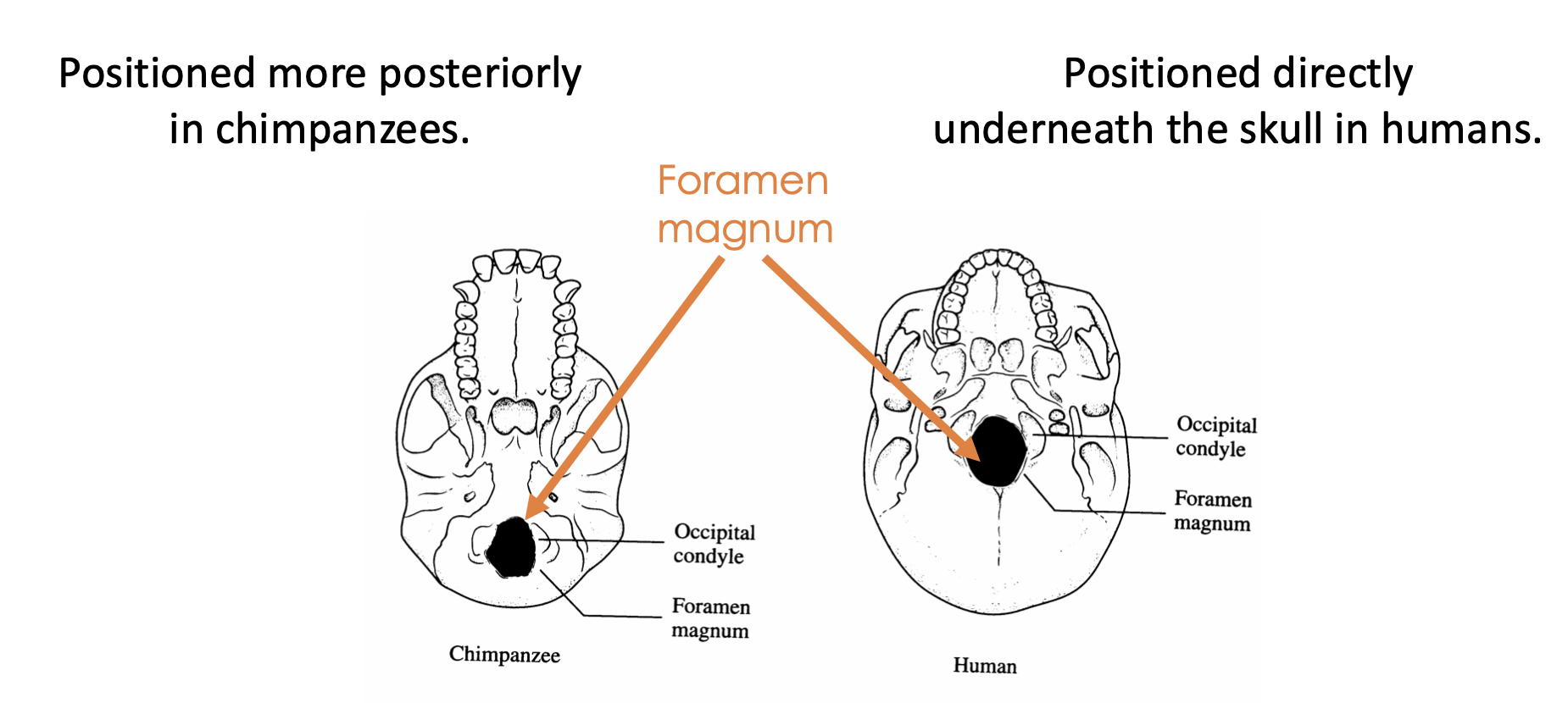
spine: thoracic and lumbar curvatures maintain center of gravity over the pelvis
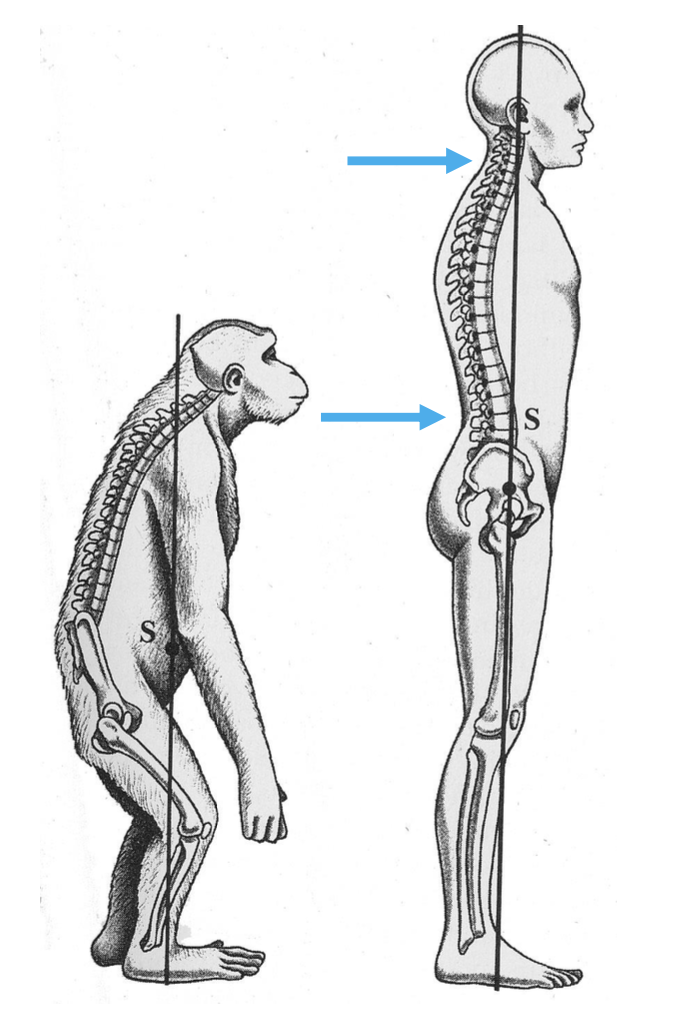
pelvis shape
femur angle
foot (do they have opposable toes)
adaptive explanations for the origin of bipedalism
social factors
carrying tools, infants, food
provisions for the “Family”

ecological factors
moving more efficiently on the ground
thermoregulation
finding food and spotting predators over tall grass
diet in hominins
teeth interact with the food we eat as individuals
diet can be inferred from tooth size and shape, tooth microwear, and isotypes
microscopic scratches and pits on the teeth occur from food being chewed
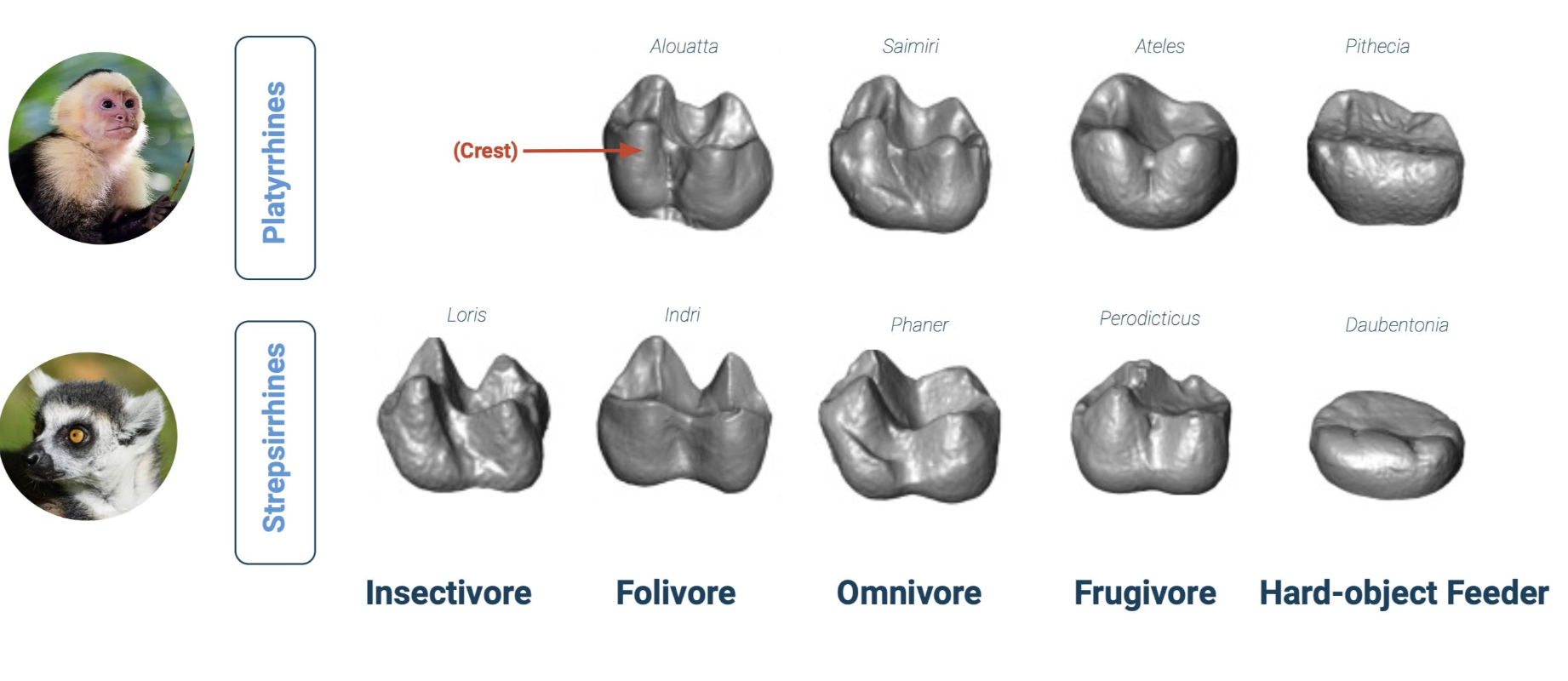
evolution of tool use
allows access to resources that may have previously been inaccessibe
paleoarchaeological record
stone tools
generally organic materials to not preserve,
brain evolution
modern humans have large brains relative to body size
increase in brain size throughout human evolution
genetic evolution in hominins
tracked through both nucleic DNA and mitochondrial DNA
1-4% of the genome of eurasian people comes from neanderthals
what are the four main topics of evolutionary medicine?
why do we age and die
maladaptation and diseases of civilization
epidemiology and managing pathogen evolution
antibiotics and evolving superbugs
rate of living theory
aging as a consequence of accumulation of irreparable damage to cells and tissues
natural selection has already pushed lifespan to the maximum
maximum lifespans observed by different species today are bound by intrinsic constraints that are impossible for natural selection overcome
see card for main preidctions
predictions of rate of living theory
the higher the metabolic rate, the lower the lifespan
because cell and tissue damage are caused in part by the by-products of metabolism, the aging rate should be correlated with metabolic rate
selections on longevity should not lead to longer lifespans
in other words, lifespan is not evolvable
evolutionary theories of aging
under the evolutionary theory, aging is not caused by cell and tissue damage
it is instead caused by failure of organisms to repair such damage
failure to repair caused by:
mutation accumulation hypothesis
antagonistic pleiotropy hypothesis
mutation accumulation hypothesis
deleterious mutations that cause failure to repair accumulate due to lack of selection
antagonistic pleiotropy hypothesis
mutations can create tradeoffs between repair and other fitness related functions
some genes have beneficial effects early in life (things like increasing reproductive success buy can be harmful later in life (like contributing to aging or disease
simply put, this is known as the fitness cost of longevity
ecology and the evolution of aging
evolution of aging shaped by the rate of extrinsic mortality:
the likelihood that external factors like predation, disease, resource limitation, or exposure to environmental stress can kill an organism
two major strategies:
reproduce fast and die young
reproduce fast and die old
how is aging built into our genome?
deleterious mutations have accumulated in our genomes for millions of years
many have likely only become visible in recent times as human lifespans have increased
ex: aging related diseases
many have and will be sticking around because carriers actually have higher fitness